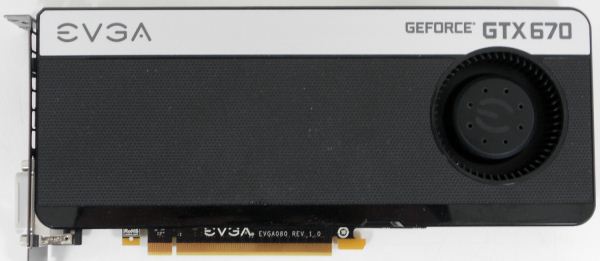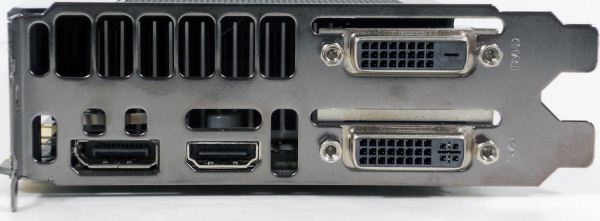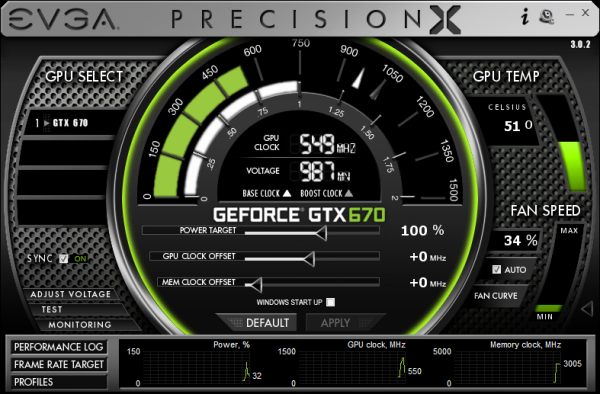NVIDIA GeForce GTX 670 Review Feat. EVGA: Bringing GK104 Down To $400
by Ryan Smith on May 10, 2012 9:00 AM ESTMeet The EVGA GeForce GTX 670 Superclocked
Our second card of the day is EVGA’s GeForce GTX 670 Superclocked, which in EVGA’s hierarchy is their first tier of factory overclocked cards. EVGA is binning GTX 670s and in turn promoting some of them to this tier, which means the GTX 670 Superclocked are equipped with generally better performing chips than the average reference card.
| GeForce GTX 670 Partner Card Specification Comparison | ||||
| EVGA GeForce GTX 670 Superclocked | GeForce GTX 670 (Ref) | |||
| CUDA Cores | 1344 | 1344 | ||
| Texture Units | 112 | 112 | ||
| ROPs | 32 | 32 | ||
| Base Clock | 967MHz | 915MHz | ||
| Boost Clock | 1046MHz | 980MHz | ||
| Memory Clock | 6210MHz | 6008MHz | ||
| Memory Bus Width | 256-bit | 256-bit | ||
| Frame Buffer | 2GB | 2GB | ||
| TDP | 170W | 170W | ||
| Manufacturing Process | TSMC 28nm | TSMC 28nm | ||
| Width | Double Slot | Double Slot | ||
| Length | 9.5" | 9.5" | ||
| Warranty | 3 Years | N/A | ||
| Price Point | $419 | $399 | ||
For the GTX 670 SC, EVGA has given both the core clock and memory clock a moderate boost. The core clock has been increased by 52MHz (6%) to 967MHz base and 66MHz (7%) boost to 1046MHz. Meanwhile the memory clock has been increased by 202MHz (3%) to 6210MHz.
Other than the clockspeed changes, the GTX 670 SC is an almost-reference card utilizing a reference PCB with a slightly modified cooler. EVGA is fabricating their own shroud, but they’ve copied NVIDIA’s reference shroud down to almost the last detail. The only functional difference is that the diameter of the fan intake is about 5mm less, otherwise the only difference is that EVGA has detailed it differently than NVIDIA and used some rounded corners in place of square corners.
The only other change you’ll notice is that EVGA is using their own high flow bracket in place of NVIDIA’s bracket. The high flow bracket cuts away as much metal as possible, maximizing the area of the vents. Though based on our power and temperature readings, this doesn’t seem to have notably impacted the GTX 670 SC.
While we’re on the matter of customized cards and factory overclocks, it’s worth reiterating NVIDIA’s position on factory overclocked cards. Reference and semi-custom cards (that is, cards using the reference PCB) must adhere to NVIDIA’s power target limits. For GTX 670 this is a 141W power target, with a maximum power target of 122% (170W). Fully custom cards with better power delivery circuitry can go higher, but not semi-custom cards. As a result the flexibility in building semi-custom cards comes down to binning. EVGA can bin better chips and use them in cards such as the Superclocked – such as our sample which can go 17 boost bins over the base clock versus 13 bins for our reference GTX 670 – but at the end of the day for stock performance they’re at the mercy of what can be accomplished within 141W/170W.
In any case, as the card is otherwise a reference GTX 670 EVGA is relying on the combination of their factory overclock, their toolset, and their strong reputation for support to carry the card. EVGA has priced the card at $419, $20 over the GTX 670 MSRP, in-line with other factory overclocked cards.
On the subject of pricing and warranties, since this is the first EVGA card we’ve reviewed since April 1st, this is a good time to go over the recent warranty changes EVGA has made.
Starting April 1st, EVGA has implemented what they’re calling their new Global Warranty Policy. Starting July 1st, 2011 (the policy is being backdated), all new EVGA cards ship with at least a 3 year warranty. And for the GTX 600 series specifically, so far EVGA has only offered models with a 3 year warranty in North America, which simplifies their product lineup.
To complement the 3 year warranty and replace the lack of longer term warranties, EVGA is now directly selling 2 and 7 year warranty extensions, for a total of 5 and 10 years respectively. So instead of buying a card with a 3 year warranty or a longer warranty, you’ll simply buy the 3 year card and then buy a warranty extension to go with it. However the extended warranty requires that the card be registered and the warranty purchased within 30 days.
The second change is that the base 3 year warranty no longer requires product registration. EVGA has other ways to entice buyers into registering, but they’ll now honor all applicable cards for 3 years regardless of the registration status. At the same time the base 3 year warranty is now a per-product warranty (e.g. a transferable warranty) rather than per-user warranty, so the base warranty will transfer to 2nd hand buyers. The extended warranties however will not.
The third change is how EVGA is actually going to handle the warranty process. First and foremost, EVGA is now allowing cards to be sent to the nearest EVGA RMA office rather than the office for the region the card was purchased from. For example a buyer moving from Europe to North America can send the card to EVGA’s North American offices rather than sending it overseas.
Finally, EVGA is now doing free cross shipping, alongside their existing Advanced RMA program. EVGA will now cross-ship replacement cards for free to buyers. The buyer meanwhile is responsible for paying to ship the faulty card back and putting up collateral on the new card until EVGA receives the old card.
There’s also one quick change to the step-up program that will impact some customers. With the move to purchasing extended warranties, the step-up program is only available to customers who either purchase an extended warranty or purchase an older generation card that comes with a lifetime warranty. Step-up is not available to cards with only the base 3 year warranty.
Moving on, along with EVGA’s new warranty EVGA is bundling the latest version of their GPU utilities, Precision X and OC Scanner X.
Precision X, as we touched upon quickly in our GTX 680 review, is the latest iteration of EVGA’s Precision overclocking & monitoring utility. It’s still based on RivaTuner and along with adding support for the GTX 600 series features (power targets, framerate caps, etc), it also introduces a new UI. Functionality wise it’s still at the top of the pack along with the similarly RivaTuner powered MSI Afterburner. Personally I’m not a fan of the new UI – circular UIs and sliders aren’t particularly easy to read – but it gets the job done.
OC Scanner X has also received a facelift and functionality upgrade of its own. Along with its basic FurMark-ish stress testing and error checking, it now also offers a basic CPU stress test and GPU benchmark.



















414 Comments
View All Comments
CeriseCogburn - Sunday, May 13, 2012 - link
Are you going to put up with crashing amd drivers and a burning electric bill OC with added instability and a water tower cost and then all of a sudden save a miniscule bit on card cost ? Are you going to add to your suffering with no adaptive v-sync, no also added smooth frame rate target, no instant per game optimum settings from a massive nVidia server farm embedded automagically in the superior nVidia drivers ?Are you going to stand for no bezel peek feature ?
Are you going to put up with the more expensive and hassled 3 monitor connection issues of the amd cards ?
Are you going to sit there undisturbed by the epic failure of amd 3D gaming vs Nvidia's available and awesome implementation ?
Are you going to put up with no amd 120hz monitor support there too ?
Isn't your original stance there the very opposite of "no one buys these cards to run on just one monitor and certainly not 1900x1200" argument ?
Since the amd overlcocks "so well" as you claim vs nVidia, what is amd releasing a pre overclocked version going to do other than allow amd partners to charge more ?
ROFL - it will do nothing.
saturn85 - Monday, May 14, 2012 - link
the folding@home benchmark is great!!i think the performance unit "point per day (ppd)" is preferable compare to "nanosecond per day (ns/day)".
TheMan876 - Tuesday, May 15, 2012 - link
Glad to see 3 monitor resolutions getting benchmarked since I just moved to that setup. Can't wait to see SLI on this card!Death666Angel - Thursday, May 17, 2012 - link
Prices for the GTX 670 and the HD 7970 are similar in Germany, at max a difference of about 30€. :-)If I had to buy a card today, I'd probably get a GTX 680, but I don't regret the 500€ I spent on a 7970 with a watercooling block and OC capabilities of 1300/1700. :-)
Brainling - Thursday, May 24, 2012 - link
I had been waiting patiently for the release of the 670 or the 660ti, depending on availability, cost and performance. After reading this review of the 670, I bought one on the spot (release day morning, while Newegg still had some)....it was a good decision.This card replaced an HD6870, and while that was a decent card, it's like night and day. In informal tests I did, I found this card to be twice as powerful in most scenarios. Nvidia has really outdone themselves with their new Kepler architecture. They've created one of the most powerful hyper-parallel architectures available to do, and have done so at greatly decreased power draw and heat (aka: less noise). It's rare to ever see my 670 spike above 60C, with the stock blower cooler.
All in all a great purchase, and one I'm very glad I made.
smartypnt4 - Sunday, May 27, 2012 - link
I know they're on the site in other reviews, but it would be nice if you could include a few dual-GPU cards in the benchmark comparisons. It probably only matters to a few people like me, but it'd be nice to have.For me, I want them because I'm trying to make a decision: do I get a second 6950 to crossfire with the one I already have for $200, or do I go out and buy a new card?
From what I've seen, outside the edge case games such as Batman and some of the games running on Frostbite, a 6990 pretty much trades blows with the 680 and the 7970. So, I'm thinking that for me, since I have the headroom in my PSU, getting a second 6950 makes a whole lot of sense, even though the setup will consume almost twice as much power as one new card.
Just my two cents.
codeus - Monday, June 4, 2012 - link
Good review but so much focus on EVGA's warranty changes smacks of this being a sponsored (and therefore biased?) review.pilotofdoom - Monday, June 11, 2012 - link
Anyone else notice that the GTX 670 outperformed the GTX 680 in the Microsoft’s Detail Tessellation test on Normal settings?I'm guessing it's a simple mistake, since there's no mention of the reversal in the text. Not like it really matters anyways, being a synthetic benchmark compared to actual gaming performance.
chrisrobhay2 - Friday, June 29, 2012 - link
Which leader does Anandtech use for the Civilization V Compute test? I'm just curious because my overclocked GTX 670 wipes the floor with all of these cards in almost all of the leader tests, so I want to make sure that I'm looking at the right information.warmbit - Tuesday, July 17, 2012 - link
If you want to see what we really have GTX670 performance in games is worth taking a look at this overview:http://warmbit.blogspot.com/2012/05/analiza-wyniko...
On the right side, select your language for translation (Google Translate).